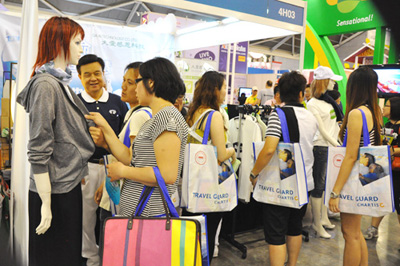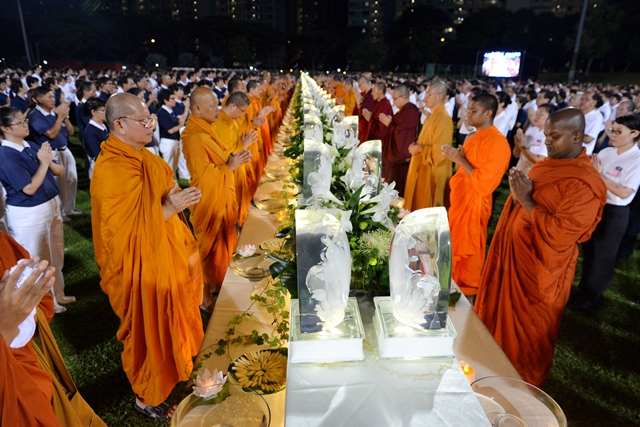
During the disaster drill, the second batch of volunteers were all geared up for action, ready to set off from Jing Si Hall to travel to KK Women’s and Children’s Hospital to take over from the first batch of volunteers.
At 8.15am on the morning of 1st July, a chemical explosion happened somewhere in Singapore. KK Women’s and Children’s Hospital (KKH) immediately issued an SOS request to Tzu Chi for volunteers to provide assistance to the families of disaster victims. In response to the crisis, the Tzu Chi Foundation (Singapore) mobilized its volunteers at around 8.40am. Besides providing personnel support, it also set up a disaster response centre at its premises, the Jing Si Hall.
In fact, this was only an emergency exercise. Every five to six years, KKH will conduct a disaster drill. In its critical role as a KKH Crisis Casualty Buddy, this year marked Tzu Chi’s third participation in such an exercise to accompany and care for the family members of disaster victims, while the hospital took care of all medical procedures.

On the day of the disaster drill, volunteer leaders Ong Lee Fung (left) and Loh Shu Hon (right) arrived at the Jing Si Hall at lightning speed. They are seen here on their mobile phones, activating volunteer manpower for the exercise via the WhatsApp social media platform.
At 8.40am in the morning, the volunteer mobilization message was disseminated to Tzu Chi volunteers island-wide via the WhatsApp social media platform. Five minutes later, the disaster response centre was officially set up in the Jing Si Hall, and by 9.30am, the first batch of 40 volunteers had arrived at KKH, awaiting further instructions.
After registration, the volunteers were grouped into pairs. The disaster drill was conducted in the hospital basement’s Children’s Emergency Department, Day Surgery Department, and Rehabilitation Department, while the first floor was turned into a waiting area for the hospital’s social service workers and family members as well as volunteers.
Tzu Chi volunteers’ scope of services were mainly to act in concert with the hospital’s efforts during disaster moments in providing care and companionship to anxious relatives, while at the same time, comfort and assist the injured young patients.
Even though Singapore is a relatively safe nation, natural or man-made disasters may strike without warning, so it is important to always stay prepared. When the head of Tzu Chi’s Charity Development Department, Karen Lim, received the notice from KKH about the disaster drill scheduled for this year, she immediately made a recommendation to the management team of the Foundation, to take advantage of this opportunity to activate for the first time the NGO’s disaster preparedness and response mechanism. This would help to assess the volunteers’ disaster readiness and response capabilities in case of future need, for it is not a question of whether a disaster will happen, but a question of when, just as the SGSecure posters remind us so succinctly, “Not if, but when.”

About an hour after the disaster response centre was set up, volunteers and community leaders from various functional groups arrived in the Jing Si Hall and convened their first meeting.
The Tzu Chi disaster response centre included various functional teams, such as the coordination team, the general affairs team, the finance team, the public relations team, as well as volunteer teams island-wide. Prior to the day of the disaster drill, a general briefing was held on 28th June at the Jing Si Hall, to enable every volunteer and staff to understand their roles and processes in the disaster relief work.

As there was a Hari Raya celebration for Muslim aid recipients on the following day of the disaster drill, volunteers used some of the goods to be given to the beneficiaries for packing as disaster relief supplies during the exercise.

Volunteers meticulously discussing the best way to pack the aid supplies.

Volunteers setting up the Buddha Hall, which was used as the venue for the disaster information centre.
As volunteers have to take turns to perform care duties that may stretch over many days in the event of a disaster, this exercise also planned a workflow for the exchange of duties between volunteers from two batches.
First-time volunteer with the disaster exercise Leong Kar Tsing said that when he was in the hospital’s waiting area, he felt quite overwhelmed in the face of wailing and distraught family members of the disaster victims. During this exercise, he witnessed first-hand how social workers had to break the bad news of loved ones’ deaths to grieving relatives, and all he could offer in the meantime was some comforting words and gestures to physically support them.
Another volunteer Soh Siew Tin shared that she experienced the importance of remaining level-headed in the event of a sudden disaster, in order to make wise decisions and choices. Faced with a young victim who was shaking with fear, she subconsciously knew that all the child needed was a hug, and comforted the shivering child. After the incident, the student who was acting as the disaster victim even praised her hug for its comforting effect.
The disaster simulation exercise wrapped up by around 1pm. After the completion of the activities, the volunteers at KKH made their way back to Jing Si Hall to share their learning points and review the operating procedures. When the CEO of Tzu Chi Foundation (Singapore), Low Swee Seh, was making his summary, he thanked KKH for the opportunity to participate in the exercise. He also reminded all volunteers to bear in mind the importance of keeping safety first in the process of disaster relief, and did not want anyone to ignore personal safety while doing disaster relief work.
The Ministry of Health (MOH), which led this emergency response exercise, highly affirmed the tireless efforts of Tzu Chi volunteers in coming alongside hospital social workers, so that the medical personnel could focus on their trained vocation to save lives, which is imperative in a disaster situation.



